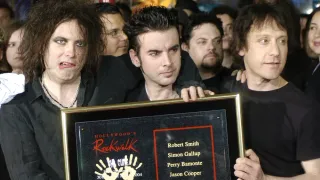May 11, 2016
Martha Graham Studio Presents 'The Deborah Zall Project: In the Company of Women'
EDGE null READ TIME: 5 MIN.
On May 13 and 14, the Martha Graham Studio Theater teams up with the nonprofit company, Classic Contemporary Dance Heritage Ltd. to present "The Deborah Zall Project: In the Company of Women."
Deborah Zall left the Martha Graham fold to pursue an independent career as a soloist, creating dramatic portrayals of women that are based primarily on works of dramatic literature. Her signature pieces include dances inspired by female characters drawn from Eugene O'Neill, Edna St. Vincent Millay, Tennessee Williams and F. Garcia Lorca. Last year, she was convinced to re-stage six of her classic female solos for past and present Martha Graham Dance Company members. �
The resulting evening, titled "The Deborah Zall Project: In the Company for Women," was mounted as an informal presentation in the Martha Graham Studio Theater in Westbeth. It proved so sensational that Zall was pressed to remount the evening this year as a full production. �This time, it'll be done with four of her own pieces plus two complimentary works drawn from the Anna Sokolow Company. The concert will bear the same name and will be presented May 13 and 14, again at the Martha Graham Studio Theater.
Zall sees herself as largely an artistic descendant of Graham, but her interests have ranged toward the literary. Her main works focus on the mental journeys of "falling women" characters of great dramatic works. In her "Mary Tyrone," set to music of Schoenberg, the mother character of O'Neill's "Long Day's Journey into Night" confronts her drug addiction, weighing whether to take a fix of morphine.
In "Amanda," inspired by "The Glass Menagerie," the mother character studies herself in a mirror, comparing the woman she sees to the belle she was, popular and besieged by gentlemen callers. In "Sonnet," based on a poem by Edna St. Vincent Millay, a woman struggles to forget a lost lover. In a piece devoted to George Sand, the author reflects on having always been an artist, for better or for worse. "Shadow of a Sister," drawn from Lorca's "The House of Bernarda Alba," examines two of the play's five sisters in a dance about their clash of wills.
The request to remount these works originally came from three Graham Company members, past and present -- Blakely White McGuire, Kim Jones and Nya Jones -- who asked if Zall would consider re-staging her solos for them.�A bit overwhelmed but flattered, she thought, "Why not?" Adding Jennifer Conley, Erica Dankmeyer and Carrie Ellmore Tallitsch to the ensemble, she set about to see the reaction to old fashioned dramatic narrative solos.
It was a revelation to Zall that a new generation of Graham artists would want to perform her work.�It's also extraordinary, she says, for her to return to the Graham conclave with the very works she had once left it behind for.�She had taught Graham technique there and these techniques are strong in her work. �
"Old fashioned emotion is not wrong," she asserts. "They see the blood of Martha in these dances." Still, it was unexpected to be ratified so strongly for her vision by a new generation of the Graham family.�Zall said, "To keep archival works alive is very important because you learn from the past.�It brings you to the present and we mustn't invalidate it. The excitement for me is how people are reacting. The reality, I guess, is that truth is still popular and women's issues are still part of the world."
The dances had proved their ability to communicate through the years in real-world, nontraditional venues. Zall performed her Mary Tyrone piece in real-life drug rehab centers in the 1970s. Patients there would laugh and cry. Works on other women's tragedies resonated strongly with women in various other types of institutions, like homeless shelters and Rikers and Bayview prisons.
Two of this concert's six dances showcase members of the Anna Sokolow Company; their presence in this concert is an homage by Zall to Sokolow, who created for Zall one of her greatest signature pieces, "Kaddish" (which Zall then built upon into "Kaddish for Ten Women"). Zall said it is hard to overestimate the importance of Sokolow to her; she wanted to have Sokolow dances represented as a tribute.
PROGRAM
"Amanda," choreographed by Deborah Zall, inspired by "The Glass Menagerie" by Tennessee Williams.�Original music by Stephen Weinstock. Performed by Erica Dankmeyer. (10 min)
"Sonnet," choreographed by Deborah Zall, based on "Sonnet II" by Edna St. Vincent Millay. �Original music by Eugene Lester, Poem spoken by Geraldine Johns. �Danced by Jennifer Conley. (10 min)
"George Sand," an excerpt from "Labonne Dame: Remembering George Sand" (1998), choreographed by Deborah Zall, text created by Mary Humphrey Baldridge, narrated by Geraldine Johns. Danced by Erica Dankmeyer. �Music by Chopin. (7 min)
"September Sonnet," choreographed by Anna Sokolow, danced by Lauren Neslund and Luis Gabriel Zaragove to music by Alban Berg. (10 min)
Intermission (15 min)
Excerpt from "Lyric Suite" choreographed Anna Sokolow, danced by Jennifer Conley (10 min)
"Shadow of her Sister" choreographed by Deborah Zall, based on F. Garcia Lorca's "The House of Bernarda Alba," performed by Lauren Newman as Angustius and Dani Stinger as Adela. �Music by Robert H. Waldman. (15 min)
"The Deborah Zall Project: In the Company of Women" will be held at 8 p.m. on May 13-14 at Martha Graham Studio Theater at Westbeth, 55 Bethune Street, 11 fl. Tickets are $30 gen. adm., $15 seniors and students.
For information or tickets, call 212-868-4444 or visit www.smarttix.com or www.deborahzall.com






